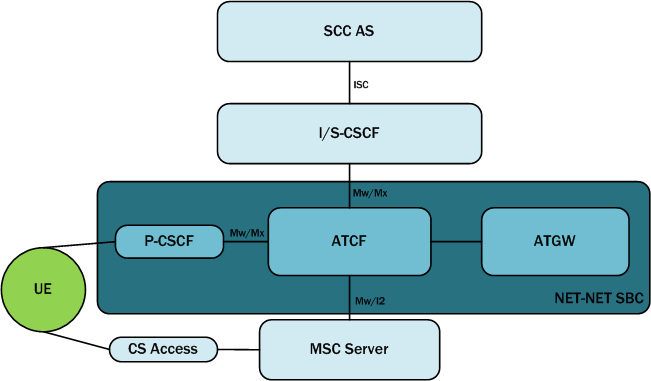Anchors for Signaling and Media
Release 10 addresses the latency concern by proposing these two logical entities, the anchoring points called the ATCF and ATGW. The Oracle Communications Session Border Controller (SBC) can fulfill the tasks set to both entries:
- ATCF—A signaling anchor
point co-located with the UE access network. The ATCF is responsible for:
- Allocating the Session Transfer Number for Single Radio (STN-SR).
- Instructing the ATGW to anchor the media path for originating and terminating sessions.
- Tracking sessions (in alerting, active, or held states) so it can perform the access transfer of the selected session. Tracking this information allows the ATCF to support transferring the first session.
- Performing Access Transfer and updating the ATGW with the new media path for the access call leg, without requiring updating from the remote leg.
- After the access transfer, updating the Service Centralization and Continuity Application Server (SCC AS) that the transfer has taken place, ensuring that the Terminating Access Domain Selection (T-ADS) has updated information about the access currently used.
- Handling failures during the access transfer.
- Handling mid-call support for the access transfer using MSC server-assisted mid-call support.
- Access Transfer Gateway (ATGW)—A media anchor point co-located with the UE access network. Controlled by the ATCF, the ATGW anchors media both for the duration of a call and after the access transfer, based on the local configuration in the serving network.
Originating and terminating sessions are anchored in the ATCF and ATGW already during session set-up. For the first transferred session and the second established session, the SCC-AS provides session state information for the alerting, held, and conference states.
When a UE makes or receives a call, signaling and media are anchored at the ATCF and ATGW. At the point call handover point, the Visited-Mobile Switching Center (V-MSC) receives the handover message from Mobility Management Entity (MME, an EPC network element). The V-MSC then sends a call request to the local ATCF rather than sending the call request home or to the SCC-AS, as defined in 3GPP Release 8. Sending the call request to the ATCF reduces the number of hops required to initiate a media stream change to a new access network.
Acting as the ATGW, the SBC can immediately affect media switchovers without further core signaling. In this role, the SBC keeps RTP media continuity between endpoints using its Hide Media Update (HMU) functionality: The elements on the core side of the eSRVCC update will not see changes to SDP sources and destinations because the Synchronization Source identifiers (SSRCs) are masked. Media can thus flow directly to and from the 3G-attached MSC and onward to the UE with minimal interruption.

Note that if the MSC server-assisted mid-call feature is not supported or MSC server is not enhanced for ICS support, the interface between the MSC server and the ATCF will be Mw. If the MSC server-assisted mid-call feature is supported or the MSC server is enhanced for ICS, the interface between the MSC server and the ATCF will be I2.